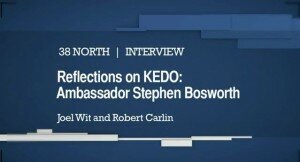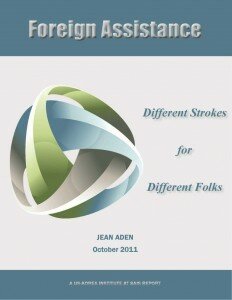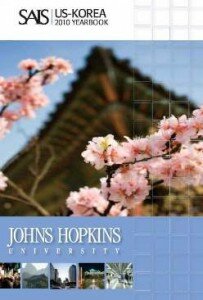Published on July 19, 2012
USKI’s 38 North and Stanford University’s Center for International Security and Cooperation (CISAC) have launched new resources on the history of KEDO to help increase public understanding of what this project was and what it accomplished.
When the South Korean fast ferry Hankyoreh sailed out of North Korean waters into the cold wind and waves of the East Sea on the morning of 8 January 2006, it carried a sad and somber group of South Korean workers, ROK officials, and personnel from the Korean Peninsula Energy Development Organization (KEDO). These were all that remained of a decade long multinational effort transforming what in 1994 had been only a paper notion into a modern construction complex of steel and concrete. KEDO’s profile on the North Korean landscape was unmistakable, its impact on Pyongyang profound. Yet, real knowledge and understanding about the organization in public and official circles in South Korea, Japan, and the United States was terribly thin at the beginning, and remains so to this day. ~ A History of KEDO 1994-2006
 In conjunction with the release of CISAC’s new book, A History of KEDO 1994-2006–an oral history project meant to preserve what remains of the living memory about KEDO, of the thinking that went into setting up the organization, the efforts to coordinate plans and translate them to realities on the ground in North Korea, and the struggle to maintain a sense of sanity while KEDO was pushed and pummeled into disintegration–USKI’s 38 North launches a new video: “Reflections on KEDO.” In this video, Joel Wit (38 North founder and Visiting Scholar at the US-Korea Institute at SAIS), hosts a conversation with Ambassador Stephen Bosworth (former US Special Representative for North Korea Policy and current Dean of The Fletcher School at Tufts University) and Robert Carlin (CISAC Visiting Scholar), about their experiences with KEDO. All three were involved with KEDO at different times in its ten year history and provide insights into what it was like on the ground building this multilateral organization. They discuss some of the major challenges in dealing with the North Koreans, as well as the cultural learning curve faced by KEDO’s multicultural staff. From the perspective of direct experience, they examine both KEDO’s accomplishments and the opportunities missed by the organization’s abrupt termination. In the final segment, Ambassador Bosworth also reflects on the Obama administration’s North Korea policy and provides his views on how to improve relations with the North in the future.
In conjunction with the release of CISAC’s new book, A History of KEDO 1994-2006–an oral history project meant to preserve what remains of the living memory about KEDO, of the thinking that went into setting up the organization, the efforts to coordinate plans and translate them to realities on the ground in North Korea, and the struggle to maintain a sense of sanity while KEDO was pushed and pummeled into disintegration–USKI’s 38 North launches a new video: “Reflections on KEDO.” In this video, Joel Wit (38 North founder and Visiting Scholar at the US-Korea Institute at SAIS), hosts a conversation with Ambassador Stephen Bosworth (former US Special Representative for North Korea Policy and current Dean of The Fletcher School at Tufts University) and Robert Carlin (CISAC Visiting Scholar), about their experiences with KEDO. All three were involved with KEDO at different times in its ten year history and provide insights into what it was like on the ground building this multilateral organization. They discuss some of the major challenges in dealing with the North Koreans, as well as the cultural learning curve faced by KEDO’s multicultural staff. From the perspective of direct experience, they examine both KEDO’s accomplishments and the opportunities missed by the organization’s abrupt termination. In the final segment, Ambassador Bosworth also reflects on the Obama administration’s North Korea policy and provides his views on how to improve relations with the North in the future.
My personal conclusion was they [North Koreans] were very serious about what they were doing—the enterprise that we were involved in. This was not something just being done for show. For them, it was not just KEDO and the Agreed Framework and light water reactors, but it was clear for many of them this was important because it was setting a series of precedents for how North Korea could begin to engage with rest of the world in a more direct and active fashion. ~ Ambassador Stephen Bosworth, “Reflections on KEDO,” a 38 North interview
Find the 38 North video here.
Published on February 16, 2012
 As part of our Working Paper Series on the Nuclear Security Summit, Mark Fitzpatrick and Jasper Pandza (International Institute for Strategic Studies) discuss the purpose and progress of the NSS process and possible ways to maintain the momentum built by the process post 2012 in Seoul and 2014 in the Netherlands.
As part of our Working Paper Series on the Nuclear Security Summit, Mark Fitzpatrick and Jasper Pandza (International Institute for Strategic Studies) discuss the purpose and progress of the NSS process and possible ways to maintain the momentum built by the process post 2012 in Seoul and 2014 in the Netherlands.
Download “Maintaining High-Level Focus on Nuclear Security.”
For related presentations and papers, check out our Nuclear Security Summit program page.
Published on October 5, 2011
 The US-Korea Institute at SAIS is pleased to release the first report in a three-part series by Dr. Jean Aden, examining South Korea’s ODA future.
The US-Korea Institute at SAIS is pleased to release the first report in a three-part series by Dr. Jean Aden, examining South Korea’s ODA future.
Having accomplished one of the most successful economic transformations of the twentieth century, transitioning from a major aid recipient to major aid provider within fifty years, Korea has recent firsthand development knowledge and experience to share with others who are in the process of development, and is keen to develop its position as a donor and member of the international donor community, commensurate with the size of its economy. Despite having only recently joined the DAC, the OECD’s choice to locate the 4th High Level Forum for Development Effectiveness (HLF-4) in Busan in November 2011 is an indicator of Korea’s potential to help shape the strategic agenda, while expanding its own development commitments. read more …
Published on September 15, 2011
 On September 22, 2011, the U.S.-Korea Institute at SAIS, in partnership with Peking University Center for International and Strategic Studies and Chung Ang University Graduate School of International Studies will host a one-day conference exploring the numerous political changes that will take place throughout Asia and the United States in 2012.
On September 22, 2011, the U.S.-Korea Institute at SAIS, in partnership with Peking University Center for International and Strategic Studies and Chung Ang University Graduate School of International Studies will host a one-day conference exploring the numerous political changes that will take place throughout Asia and the United States in 2012.
Panels will discuss what 2012 leadership may look like for the United States, South Korea, Japan, China, Russia and North Korea, as well as what the effects of these changes might have on regional security and security cooperation in the future.
For a full list of speakers and to RSVP, click here.
Published on May 7, 2011
 The U.S.-Korea Institute at SAIS is pleased to announce the release of the 2010 Edition of the SAIS U.S.-Korea Yearbook.
The U.S.-Korea Institute at SAIS is pleased to announce the release of the 2010 Edition of the SAIS U.S.-Korea Yearbook.
The Yearbook analyzes important developments in North and South Korea that characterized their relations in 2010. Each paper was written by a SAIS student from the course, “The Two Koreas: Contemporary Research and Record,” in the fall of 2010. Their insights were based on extensive reading and study as well as on numerous interviews conducted with government officials, scholars, NGO workers, academics and private sector experts both in Washington and Seoul.
Explore the 2010 SAIS U.S.-Korea Yearbook.
Published on April 4, 2011
 In November 2010, the U.S.-Korea Institute at SAIS and Korea Institute of Finance, co-hosted the event, “State of the World Economy, 2011-2012: Whither or Wither?” sponsored by the Asian Studies Program at SAIS and the JoongAng Ilbo. This conference was meant to facilitate the exchange of predictions, as well as the assumptions underpinning those predictions, for the global economy over the next two years among such noted economists as Kevin H. O’Rourke, John B. Taylor, Daniel Rosen, Marcus Noland, and more. Special emphasis was placed on key economies such as China, India, Japan, and South Korea.
In November 2010, the U.S.-Korea Institute at SAIS and Korea Institute of Finance, co-hosted the event, “State of the World Economy, 2011-2012: Whither or Wither?” sponsored by the Asian Studies Program at SAIS and the JoongAng Ilbo. This conference was meant to facilitate the exchange of predictions, as well as the assumptions underpinning those predictions, for the global economy over the next two years among such noted economists as Kevin H. O’Rourke, John B. Taylor, Daniel Rosen, Marcus Noland, and more. Special emphasis was placed on key economies such as China, India, Japan, and South Korea.
This volume contains the speeches and papers (further refined and edited post-conference) presented at that conference, in order to help inform and advise both policymakers and the general public on what may be in store in the coming years.
Download “State of the World Economy, 2011-2012, Whither or Wither?“ in full or by chapter here.
Published on March 29, 2011

The U.S.-Korea Institute at SAIS and the Center for the National Interest are pleased to announce the release of the joint report “
Northeast Asia in Afghanistan: Whose Silk Road?“, co-authored by Jae H. Ku, Drew Thompson, and Daniel Wertz.
This report aims to review Northeast Asian interests in Afghanistan, assess their relevance to the United States’ bilateral relations in the region, and explore potential opportunities for expanded cooperation in the region. It reviews past contributions to Afghan reconstruction made by China, South Korea, and Japan, and analyzes each country’s strategic, economic, and security interests in Afghanistan. By exploring areas of common interest and potential cooperation, it aims to suggest opportunities to expand a multilateral strategy for bringing security and development to Afghanistan in the years ahead.
The research for this paper was generously funded through the U.S.-Korea Institute at SAIS, the Tokyo Foundation, and the China Institute of International Studies. Find out more
here.
 In conjunction with the release of CISAC’s new book, A History of KEDO 1994-2006–an oral history project meant to preserve what remains of the living memory about KEDO, of the thinking that went into setting up the organization, the efforts to coordinate plans and translate them to realities on the ground in North Korea, and the struggle to maintain a sense of sanity while KEDO was pushed and pummeled into disintegration–USKI’s 38 North launches a new video: “Reflections on KEDO.” In this video, Joel Wit (38 North founder and Visiting Scholar at the US-Korea Institute at SAIS), hosts a conversation with Ambassador Stephen Bosworth (former US Special Representative for North Korea Policy and current Dean of The Fletcher School at Tufts University) and Robert Carlin (CISAC Visiting Scholar), about their experiences with KEDO. All three were involved with KEDO at different times in its ten year history and provide insights into what it was like on the ground building this multilateral organization. They discuss some of the major challenges in dealing with the North Koreans, as well as the cultural learning curve faced by KEDO’s multicultural staff. From the perspective of direct experience, they examine both KEDO’s accomplishments and the opportunities missed by the organization’s abrupt termination. In the final segment, Ambassador Bosworth also reflects on the Obama administration’s North Korea policy and provides his views on how to improve relations with the North in the future.
In conjunction with the release of CISAC’s new book, A History of KEDO 1994-2006–an oral history project meant to preserve what remains of the living memory about KEDO, of the thinking that went into setting up the organization, the efforts to coordinate plans and translate them to realities on the ground in North Korea, and the struggle to maintain a sense of sanity while KEDO was pushed and pummeled into disintegration–USKI’s 38 North launches a new video: “Reflections on KEDO.” In this video, Joel Wit (38 North founder and Visiting Scholar at the US-Korea Institute at SAIS), hosts a conversation with Ambassador Stephen Bosworth (former US Special Representative for North Korea Policy and current Dean of The Fletcher School at Tufts University) and Robert Carlin (CISAC Visiting Scholar), about their experiences with KEDO. All three were involved with KEDO at different times in its ten year history and provide insights into what it was like on the ground building this multilateral organization. They discuss some of the major challenges in dealing with the North Koreans, as well as the cultural learning curve faced by KEDO’s multicultural staff. From the perspective of direct experience, they examine both KEDO’s accomplishments and the opportunities missed by the organization’s abrupt termination. In the final segment, Ambassador Bosworth also reflects on the Obama administration’s North Korea policy and provides his views on how to improve relations with the North in the future.






